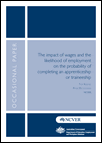Description
This paper updates an earlier paper by Karmel and Mlotkowski and looks at how the probability of getting a job, in addition to wages, impacts on completion rates. It finds that for trade apprentices the premium (or extra wage completing an apprenticeship brings) attached to becoming a tradesperson is a significant factor, whereas for non-trade trainees the training wage matters more. It also finds that the probability of employment for an apprentice or trainee on completion is greater than if they drop out; this particularly affects completion rates for trades and females in non-trade occupations. Finally, the economic downturn significantly increased the attractiveness of apprenticeships and traineeships.
Summary
About the research
This paper updates an earlier paper by Karmel and Mlotkowski, The impact of wages on the probability of completing an apprenticeship or traineeship. The major change is that this new paper looks at whether the probability of getting a job either in alternative employment or at the completion of an apprenticeship or traineeship, in addition to wages, impacts on completion rates. This issue was not considered in the earlier paper because the first Apprentice and Trainee Destinations Survey was run in 2008 when the labour market was particularly buoyant. The situation for the second survey, conducted in 2010, was very different, with unemployment in general and youth unemployment in particular increasing sharply.
Key messages
- For trade apprentices, the premium attached to becoming a tradesperson is a significant factor to completion, not the training wage. This confirms the earlier finding.
- By contrast, in the non-trades the training wage matters more. For both male and female trainees, completion rates decrease with increases in the difference between wages in alternative employment and training wages.
- Typically, the probability of employment on completion of an apprenticeship or traineeship exceeds that of the apprentice or trainee who drops out. For trades and females in non-trade occupations this difference significantly affects completion rates.
- The economic downturn significantly increased the attractiveness of undertaking an apprenticeship or traineeship. Alternative employment became less attractive compared with being an apprentice or a trainee, and in general the pay-off to completion increased.
Tom Karmel
Managing Director, NCVER
Related items
Making use of the NCVER Apprentice and Trainee Destination Survey, this paper focus on wages and the… Show more
